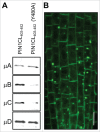Sorting signals for PIN1 trafficking and localization
- PMID: 27603315
- PMCID: PMC5155414
- DOI: 10.1080/15592324.2016.1212801
Sorting signals for PIN1 trafficking and localization
Abstract
PIN-FORMED (PIN) family proteins direct polar auxin transport based on their asymmetric (polar) localization at the plasma membrane. In the case of PIN1, it mainly localizes to the basal (rootward) plasma membrane domain of stele cells in root meristems. Vesicular trafficking events, such as clathrin-dependent PIN1 endocytosis and polar recycling, are probably the main determinants for PIN1 polar localization. However, very little is known about the signals which may be involved in binding the μ-adaptin subunit of clathrin adaptor complexes (APs) for sorting of PIN1 within clathrin-coated vesicles, which can determine its trafficking and localization. We have performed a systematic mutagenesis analysis to investigate putative sorting motifs in the hydrophilic loop of PIN1. We have found that a non-canonical motif, based in a phenylalanine residue, through the binding of μA(μ2)- and μD(μ3)-adaptin, is important for PIN1 endocytosis and for PIN1 traffcking along the secretory pathway, respectively. In addition, tyrosine-based motifs, which also bind different μ-adaptins, could also contribute to PIN1 trafficking and localization.
Keywords: Clathrin; PIN1; clathrin-adaptor complex; mu-adaptins; sorting signals.
Figures


Erratum for
- Addendum to: Sancho-Andrés G, Soriano-Ortega E, Gao C, Bernabé-Orts JM, Narasimhan M, Müller A, Tejos R, Jiang L, Friml J, Aniento F, Marcote MJ. Sorting motifs involved in the trafficking and localization of the PIN1 auxin efflux carrier. Plant Physiol. 2016 5 12; 171(3):1965–82; pii: pp.00373.2016; PMID: ; http://dx.doi.org/10.1091/mbc.12.10.2907.
Similar articles
-
Sorting Motifs Involved in the Trafficking and Localization of the PIN1 Auxin Efflux Carrier.Plant Physiol. 2016 Jul;171(3):1965-82. doi: 10.1104/pp.16.00373. Epub 2016 May 12. Plant Physiol. 2016. PMID: 27208248 Free PMC article.
-
Arabidopsis μ-adaptin subunit AP1M of adaptor protein complex 1 mediates late secretory and vacuolar traffic and is required for growth.Proc Natl Acad Sci U S A. 2013 Jun 18;110(25):10318-23. doi: 10.1073/pnas.1300460110. Epub 2013 Jun 3. Proc Natl Acad Sci U S A. 2013. PMID: 23733933 Free PMC article.
-
Arabidopsis mu A-adaptin interacts with the tyrosine motif of the vacuolar sorting receptor VSR-PS1.Plant J. 2004 Mar;37(5):678-93. doi: 10.1111/j.1365-313x.2003.01995.x. Plant J. 2004. PMID: 14871308
-
Decoding ubiquitin sorting signals for clathrin-dependent endocytosis by CLASPs.J Cell Sci. 2007 Feb 15;120(Pt 4):543-53. doi: 10.1242/jcs.03385. J Cell Sci. 2007. PMID: 17287393 Review.
-
Membrane trafficking functions of the ANTH/ENTH/VHS domain-containing proteins in plants.FEBS Lett. 2022 Sep;596(17):2256-2268. doi: 10.1002/1873-3468.14368. Epub 2022 May 30. FEBS Lett. 2022. PMID: 35505466 Review.
Cited by
-
Systematic analysis of specific and nonspecific auxin effects on endocytosis and trafficking.Plant Physiol. 2021 Jun 11;186(2):1122-1142. doi: 10.1093/plphys/kiab134. Plant Physiol. 2021. PMID: 33734402 Free PMC article.
-
Protein degrons and degradation: Exploring substrate recognition and pathway selection in plants.Plant Cell. 2024 Sep 3;36(9):3074-3098. doi: 10.1093/plcell/koae141. Plant Cell. 2024. PMID: 38701343 Free PMC article. Review.
-
Motif-based endomembrane trafficking.Plant Physiol. 2021 May 27;186(1):221-238. doi: 10.1093/plphys/kiab077. Plant Physiol. 2021. PMID: 33605419 Free PMC article.
-
Auxin Transporters-A Biochemical View.Cold Spring Harb Perspect Biol. 2022 Feb 1;14(2):a039875. doi: 10.1101/cshperspect.a039875. Cold Spring Harb Perspect Biol. 2022. PMID: 34127449 Free PMC article. Review.
-
Chloride Channel Family in the Euhalophyte Suaeda altissima (L.) Pall: Cloning of Novel Members SaCLCa2 and SaCLCc2, General Characterization of the Family.Int J Mol Sci. 2023 Jan 4;24(2):941. doi: 10.3390/ijms24020941. Int J Mol Sci. 2023. PMID: 36674457 Free PMC article.
References
-
- Krecek P, Skupa P, Libus J, Naramoto S, Tejos R, Friml J, Zazímalová E. The PIN-FORMED (PIN) protein family of auxin transporters. Genome Biol 2009; 10:249; PMID:20053306; http://dx.doi.org/10.1186/gb-2009-10-12-249 - DOI - PMC - PubMed
-
- Ganguly A, Park M, Kesawat MS, Cho HT. Functional Analysis of the Hydrophilic Loop in Intracellular Trafficking of Arabidopsis PIN-FORMED Proteins. Plant Cell 2014; 26:1570-85; PMID:24692422; http://dx.doi.org/10.1105/tpc.113.118422 - DOI - PMC - PubMed
-
- Kania U, Fendrych M, Friml J. Polar delivery in plants; commonalities and differences to animal epithelial cells. Open Biol 2014; 4:140017; PMID:24740985; http://dx.doi.org/10.1098/rsob.140017 - DOI - PMC - PubMed
-
- Adamowski M, Friml J. PIN-dependent auxin transport: action, regulation, and evolution. Plant Cell 2015; 27:20-32; PMID:25604445; http://dx.doi.org/10.1105/tpc.114.134874 - DOI - PMC - PubMed
-
- Dhonukshe P, Aniento F, Hwang I, Robinson DG, Mravec J, Stierhof YD, Friml J. Clathrin-mediated constitutive endocytosis of PIN auxin efflux carriers in Arabidopsis. Curr Biol 2007; 17:520-7; PMID:17306539; http://dx.doi.org/10.1016/j.cub.2007.01.052 - DOI - PubMed
MeSH terms
Substances
LinkOut - more resources
Full Text Sources
Other Literature Sources
Research Materials
Miscellaneous
